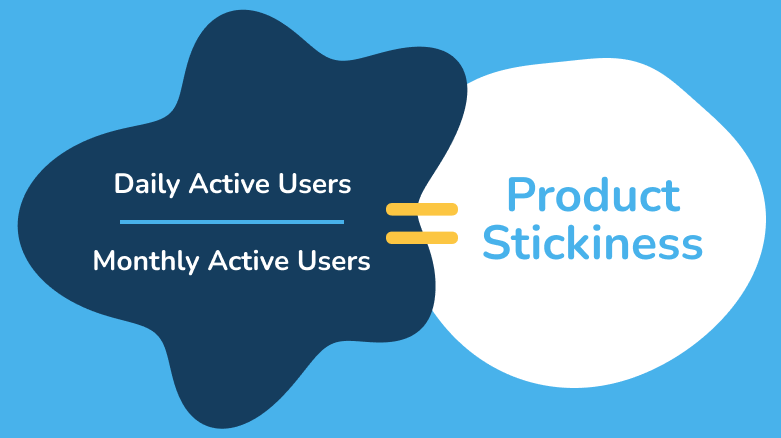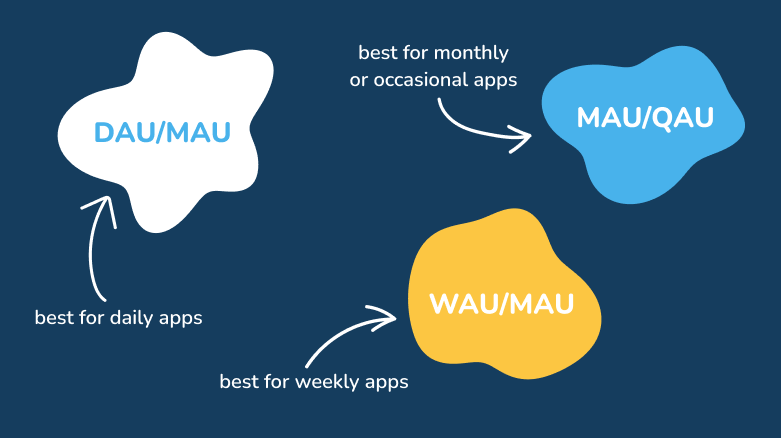Product Stickiness: Tutorial & Best Practices
You may know that the term “sticky product” doesn’t refer to a jar of honey, but do you know what one actually is? By the end of this article, you’ll not only understand what a sticky product is, you’ll learn how to measure your own product’s stickiness and have the tools you need to increase it.
What is product stickiness?
Product or customer stickiness describes the degree to which customers return to your product again and again. A sticky product strengthens the relationship with a customer over time, encouraging engagement with additional products and services throughout the customer lifecycle.
When customers place a high value on your product or services, they will engage with them often as a part of their daily workflows, making them much more likely to find value and renew their subscription.
A product’s overall stickiness can be measured using a specific metric called the DAU/MAU ratio. Facebook first popularized this ratio in the 2000s as a method to predict customer retention over a 30-day period. DAU stands for daily active users and MAU for monthly active users, meaning the number of unique visitors your product has in a day or month. The key metric is individual users who are active in a day or month — not the number of sessions. You may have a user visit several times in the course of a day, constituting several sessions, but this would only count as one daily active user.
The ratio of daily unique users to monthly unique users will give you a sense of how frequently a customer might visit and engage with your product throughout the month. The higher the ratio, the more often your customers transact with you throughout the month.
There are general baselines in the industry that have been established for a variety of product categories. For a finance app like Mint or YNAB, a ratio of 10.5% is the average. For e-commerce apps, the average ratio is 9.8%, and for SaaS products, which we’ll focus on in this article, the average DAU/MAU ratio is 13%.

The ratio of Daily Active Users (DAU) over Monthly Active Users (MAU) is called “stickiness.”
Is DAU/MAU the right metric for my product?
A metric like DAU/MAU is useful for measuring the stickiness of products that tend to see daily customer usage. Daily usage SaaS products might include project management software, communications platforms, or other productivity tools. An alternate metric might be more appropriate for tools that tend towards more infrequent use.
For example, a CRM tool for bimonthly email campaigns might be more accurately tracked with a WAU/MAU ratio (comparing weekly to monthly usage). In the case of more specialized software, like expense management tools, active users might only visit once or twice per month. In this case, MAU/QAU (monthly vs. quarterly) would be the more appropriate measurement to evaluate your product’s stickiness.

DAU/MAU is best used for apps that support daily usage. Find the right ratio for your app.
What does stickiness actually mean?
A product’s DAU/MAU ratio is just a number. What it actually translates to from a behavior perspective is that customers return to your product again and again because they find value in it. A high figure means that your product has proved its usefulness and worth to such a degree that they have incorporated it into their daily lives and routines. This is how DAU/MAU translates into customer behavior: by demonstrating that your customers have a repeating pattern of usage that represents the way that your product has become a habit or routine.
For example, if your app has a DAU/MAU ratio of 50%, this translates to customers using your product about every other day in any given month. A SaaS product with an average stickiness ratio of 13% has customers using the app about once a week.
Customers who rely on your product as part of their routine are much more likely to place a higher value on it—enough to be willing to pay for your product. This transactional value, as it’s called, might take the form of either subscription payments or repeat purchases. Stickiness focuses on transactional value specifically—buying products or subscriptions—not just engagement.
Sticky products are also more likely to generate and maintain customer loyalty. Customers who have incorporated your product into their daily lives or routine workflows will be far more apt to stay loyal and continue with your product even when alternate options may become available. This is a major component of the definition of product stickiness: customers are far more likely to “stick” with your product.
Why should you care about product stickiness?
Measuring and tracking product stickiness will help you develop a clear picture of how your product performs over time. As your product develops and matures, and as you add new features, you need a clear picture of whether you’re making the right investments in your development roadmap.
As customer stickiness increases, your churn will naturally decrease. Decreasing churn is a critical component of bringing down customer acquisition costs while increasing your customer base, thereby freeing up cash and accelerating growth. Measuring and optimizing stickiness addresses churn head-on.
Stickiness should also factor into your upsell strategy. If you attempt to upsell to customers who don’t find value in your current product, at best, your upsell efforts may be wasted; at worst, you risk alienating already unhappy customers.
Finally, a sticky product that has proven its value to a loyal customer base is one that has the best chance of leveraging the power of referrals. Using word of mouth to grow your business is a highly cost-effective (read: free) channel through which to acquire new customers.
|
Platform
|
Out-of-the-Box KPIs
|
Segmentation
|
Feature-Level Adoption & Retention Analysis
|
Cross-Channel User Engagements
|
Engagement Impact Analysis
|
A.I-Powered Product Feature Mapping
|
Mobile Application Support
|
|---|---|---|---|---|---|---|---|
|
Gainsight
|
✔
|
✔
|
✔
|
✔
|
✔
|
✔
|
✔
|
|
Heap
|
✔
|
✔
|
✔
|
✔
|
|||
|
Pendo
|
✔
|
✔
|
How is stickiness different from other metrics?
Evaluating a SaaS product’s stickiness is just one method of monitoring growth and development. Other metrics can provide helpful information, but these differ from stickiness in how they are calculated and the information they provide.
Overall engagement
Any customer who interacts with your product on a regular basis can be considered to be engaged. Infrequent users may be engaged but would not be experiencing your product as sticky; stickiness represents frequent use over a period of time.
Growth and retention
Your product may be increasing its user base over time, but are your users returning? Your product may be growing due to any number of factors, including increased marketing spend. However, if customers don’t find enough value to make your product a part of their habits and routines, you won’t see those customers retained over time. Measuring retention on its own won’t give you a good picture of how frequently and consistently your customers are engaging.
Customer satisfaction (CSAT)
Customer satisfaction is a metric that indicates how satisfied your customers are with your company’s products or services. It’s generally measured through customer feedback and is given as a percentage, with 100% being the highest possible score. While it’s important to know how satisfied your customers are with your offering, you’ll still need to measure stickiness in order to know whether that satisfaction equates to frequent usage.
What makes a product sticky?
Stickiness is all about the perceived value of your product to the customer. Saving a customer time or money, providing an indispensable convenience, or simply improving the quality of their daily work are goals you might consider for your product’s feature set.
Stickiness will also vary depending on the lifecycle of your product. Early-stage products may be more focused on growth and acquisition as they work to become established. These newer products may see a lower-than-average DAU/MAU in the early stages, and overall growth might be a more important metric to focus on. Stickiness is often a more useful metric for mature products with an established user base. As your user base grows, your relative value to users may increase due to what’s known as the “network effect”: A communication app, for instance, will be more valuable to your customers the more you onboard additional users for them to communicate with.
How do you measure customer stickiness in your product?
The first step toward measuring the DAU/MAU ratio to gauge stickiness is to define what an active user looks like for your product. The definition of activity can vary depending on your product. Working with your cross-functional partners in product, engineering, and marketing can be valuable to define the activity or activities that would constitute an active user. This might include logging in, viewing a page or set of pages, completing a task, or collaborating with other users.
You’ll also want to establish which variation of the stickiness ratio is most appropriate for your product. DAU/MAU is the most commonly used and applies to products that support a daily pattern of usage. If you’re unsure whether DAU/MAU is the right metric for your product, you can start by looking at your product’s DAU/WAU ratio. A product with a DAU/WAU of 60% or higher is very likely a daily usage product. Products that support a daily interaction pattern might include productivity, collaboration, or communication apps like Slack.
A product that lends itself to more infrequent (but still regular) usage can be evaluated for stickiness using either WAU/MAU or MAU/QAU, depending on your particular use case. Marketing or CRM tools like Mailchimp might measure WAU/MAU, and payroll tools like ADP might look more at MAU/QAU for their stickiness metric.
Another useful metric to look at for overall stickiness is a product’s Lness. Lness is defined as the number of days visited within a given time frame. An Lness of L3+/7 tells you how many users are visiting your product at least three days a week, and an Lness of L14+/30 would tell you how many users visit at least fourteen times in a given month. A B2B product used for team communication might monitor their L5+/7 Lness score if their tool is intended to be used every weekday. Measuring Lness over an extended period of time can help complete the picture of how sticky your product is, but shouldn’t be relied on as the primary metric.
What does a “good” stickiness metric look like?
Now that you are collecting and analyzing the data, how do you interpret it in order to know whether your product is truly sticky? Looking at comparative metrics for similar products in your category can provide a helpful baseline.
For a B2B product, a good average benchmark is 13%, which translates to customers using your product about once per week. Anything above a 20% stickiness ratio is considered exceptional.
If your product is weekly or monthly usage in nature and you are using an alternate measure like WAU/MAU or MAU/QAU, tracking these numbers over time will generally be more useful than trying to compare them to an industry benchmark. Apps in these categories tend to have more unique usage patterns, and one size does not fit all.
Which teams should participate in measuring product stickiness?
Measuring DAU/MAU and evaluating product stickiness should be a cross-functional effort. These are the core stakeholders who should be involved in this effort.
Product
The product team should be deeply involved in understanding product stickiness, as it will provide valuable information on where and how to invest their efforts.
Understanding app stickiness is key to successful product roadmap planning. Your app’s stickiness—or lack thereof—can help prioritize new feature development against improvements to the existing experience. If your product is mature but generally lags behind industry benchmarks for stickiness, examining the current experience and addressing gaps to improve user engagement may be far more valuable than investing effort in adding features. However, suppose your core product is simply lacking in features that provide user value. In that case, it may be more important to ship a highly engaging feature that offers your customers a reason to return to your product throughout the week.
In addition to offering a broad picture of engagement for your user base, evaluating stickiness for individual user types is a helpful exercise. Understanding the usage patterns for particular sets of user demographics can inform future features or validate current product direction. If you have a specific user segment that tends to engage most often, understanding how and why those individuals are using your product might uncover novel use cases.
Marketing or Growth
Examining stickiness can be a valuable tool in the growth, customer or product marketing toolkit. Marketers can segment users on the basis of DAU/MAU and use this breakdown to direct their marketing efforts. Using targeted campaigns aimed at low-DAU/MAU users may help increase adoption, reactivate users, and counteract customers likely to churn.
Additionally, modeling the demographics of high-DAU/MAU, high-stickiness users can provide insight for strategic new user campaigns. Targeting these campaigns toward an audience that shares characteristics with your most engaged customers will be much more effective than a broader campaign.
Your company’s growth team should be looking closely at high-DAU/MAU users whenever upsell offerings are rolled out. Your stickiest users, the ones who place the highest value on your product, are also the customers who are far more likely to be interested in premium products.
How can you increase your product’s stickiness?
So you’ve done your homework and examined your product’s DAU/MAU. You’ve compared your app to industry benchmarks and maybe realized that you have some room for improvement. How do you build a sticky, valuable, indispensable product?
When we examine DAU/MAU, what we’re looking at is how much of a daily habit your app is for your customers. We’re getting a picture of how ingrained in their daily routine your app is. Building a habit-forming app (ideally a “good” habit like productivity) requires understanding how habits are formed.
In his groundbreaking book, “Hooked,” author Nir Eyal tells us that the most successful products in the world lead us to form habits around them. These products create intensely loyal customers, provide a massive edge over the competition, and are many times less susceptible to the downside of price increases, translating to more potential for revenue from premium products. He outlines a four-step model for creating rewarding, habit-forming products but cautions us only to pursue this model if the app meets two criteria: it improves the lives of its users, and it is a product that you yourself would use.
Another key component of true stickiness is the product’s ability to “pull” users in of their own volition without reliance on “push” methods to trigger user engagement. Push notifications, emails, and other external triggers may work to boost engagement in the short term but are not sustainable. A truly sticky habit-forming product must provide enough value that customers return to it on their own.
To create increases in value that will have your customers returning to your app of their own accord, you’ll want to first examine your current customer experience. What features see the most usage right now? What opportunities or gaps exist? This is a great time to lean into user research, specifically discovery research. A customer interview series with both high- and low-stickiness users could provide valuable insights. What brings your high-stickiness users back to your app every day? What do your low-stickiness users wish your app could provide?
Driving customer activation is another way to increase stickiness by more quickly converting new users into repeat users. Focus on your product’s “aha moments,” those moments in time when a customer both understands how your product works and perceives its value. Getting your customer to that aha moment more quickly boosts your chances of retaining and converting them into repeat customers.
Another methodology you can apply to help identify those key engagement points is user segmentation. By examining high-stickiness, high-engagement customer segments, and their habits, you may be able to spot opportunities for boosting stickiness with lower-performing customer segments. For instance, if your stickiest customers tend to use two features together, you might look at how to connect those features in a more seamless way for all customers.
Whatever strategies you use to improve the stickiness of your product, it’s critical to use the build-measure-learn feedback loop, in combination with the baseline DAU/MAU you’ve established, in order to evaluate the effectiveness of your product improvements.
What are some common pitfalls to avoid?
- Stickiness is not the end-all-be-all. Churn and retention can’t be evaluated by looking at stickiness, and they are not metrics you can afford to overlook.
- Stickiness does not necessarily translate to customer satisfaction. Surveys can help you understand whether your customers are finding value in their daily usage of your product, or if there is room for improvement in the customer experience.
- Don’t use DAU/MAU if your app is not a daily, high-frequency app. For low-frequency apps, looking at customer lifetime value may be much more helpful than evaluating product stickiness.
- Make sure you’re using an appropriate benchmark. If there isn’t an established industry standard for your category, create your own benchmark by evaluating DAU/MAU over time.
- Understanding product stickiness is only as useful as what you do with it. Build and learn, using stickiness (along with other key metrics) to inform your product direction.
Let’s review
Product stickiness is the tendency of your product to generate daily usage patterns with your customers. Customers who incorporate your app into their daily lives also stay longer, tell more friends about your app, and are more willing to purchase premium features. DAU/MAU can provide a benchmark for your product’s stickiness by telling you how many customers use it over the course of a month.
To increase stickiness, focus on ways to boost repeat engagement. Aim for users to return to your product daily on their own through a “pull” model rather than relying on push notifications and other short-term strategies. You can identify opportunities to build stickiness with customer research. Understanding what provides value can also help guide new customers to the “aha moment” more quickly. The sooner they perceive value, the better your odds of converting them into happy, loyal customers of your very sticky product.



